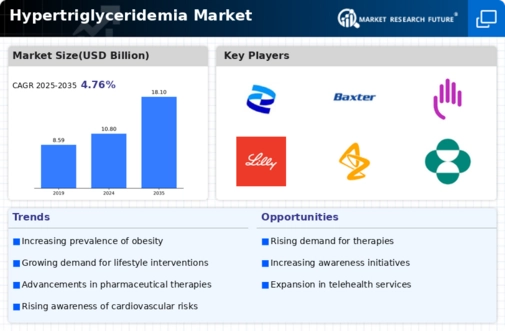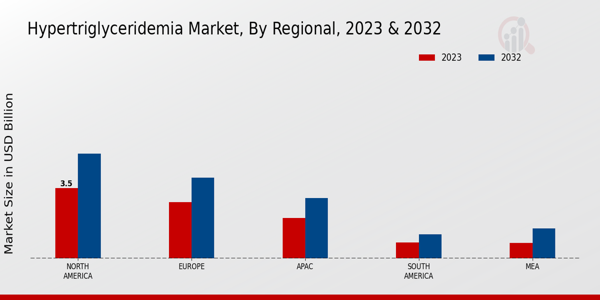Aging Population
The aging population is a significant factor influencing the Global Hypertriglyceridemia Market Industry. As individuals age, the risk of developing hypertriglyceridemia increases due to metabolic changes and the prevalence of comorbidities such as diabetes and hypertension. By 2024, the market is projected to reach 10.8 USD Billion, with the elderly demographic contributing substantially to this growth. The demand for tailored treatment options for older adults is likely to rise, prompting pharmaceutical companies to focus on developing therapies that cater specifically to this age group, thereby enhancing market dynamics.
Market Growth Projections
The Global Hypertriglyceridemia Market Industry is projected to witness substantial growth, with forecasts indicating a market value of 18.1 USD Billion by 2035. This growth trajectory reflects a compound annual growth rate (CAGR) of 4.76 percent from 2025 to 2035. Such projections highlight the increasing recognition of hypertriglyceridemia as a critical health issue, prompting investments in research and development. As the market expands, stakeholders are likely to explore new therapeutic avenues and enhance existing treatment modalities to meet the evolving needs of patients.
Advancements in Treatment Options
Innovations in pharmacological therapies are a key driver of the Global Hypertriglyceridemia Market Industry. Recent advancements in lipid-lowering medications, including novel triglyceride-lowering agents, have emerged as effective solutions for managing hypertriglyceridemia. For instance, the introduction of new classes of drugs, such as PCSK9 inhibitors and omega-3 fatty acid formulations, has shown promising results in clinical trials. These advancements not only improve patient outcomes but also expand the treatment landscape, potentially increasing market revenue as more patients gain access to these therapies.
Regulatory Support and Guidelines
Regulatory support and updated clinical guidelines play a crucial role in shaping the Global Hypertriglyceridemia Market Industry. Health authorities are increasingly recognizing the importance of managing triglyceride levels to prevent cardiovascular diseases. Updated guidelines from organizations such as the American Heart Association emphasize the need for effective treatment strategies for hypertriglyceridemia. This regulatory backing encourages healthcare providers to adopt new therapies and screening protocols, ultimately fostering market growth. As the industry evolves, adherence to these guidelines is expected to drive demand for innovative treatment solutions.
Rising Prevalence of Hypertriglyceridemia
The Global Hypertriglyceridemia Market Industry is experiencing growth driven by the increasing prevalence of hypertriglyceridemia. Factors such as sedentary lifestyles, unhealthy dietary habits, and rising obesity rates contribute to this trend. According to health statistics, the prevalence of hypertriglyceridemia is expected to rise significantly, with estimates indicating that approximately 25 percent of adults globally may be affected by elevated triglyceride levels by 2024. This growing patient population necessitates the development of effective treatment options, thereby propelling the market forward.
Growing Awareness and Screening Initiatives
The Global Hypertriglyceridemia Market Industry benefits from heightened awareness and screening initiatives aimed at identifying individuals at risk. Public health campaigns and educational programs have been implemented to inform the population about the dangers of high triglyceride levels and the importance of regular screening. As awareness increases, more individuals are likely to seek medical advice and undergo testing, leading to earlier diagnosis and treatment. This proactive approach is expected to drive market growth, as early intervention can significantly reduce the risk of cardiovascular diseases associated with hypertriglyceridemia.













